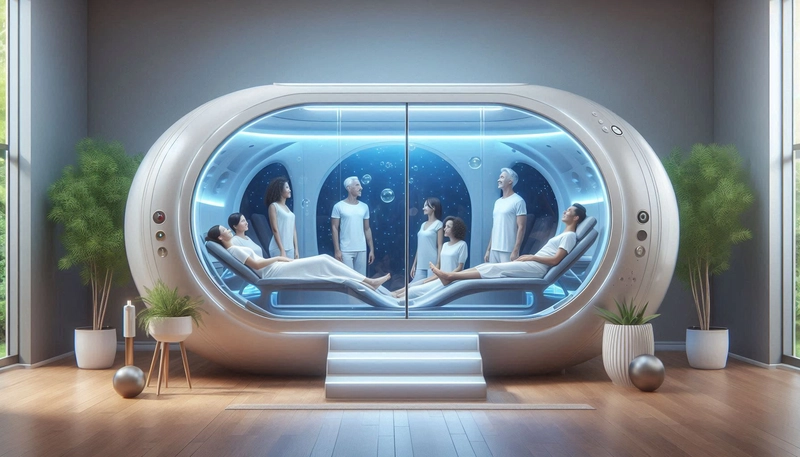Hyperbaric Chambers: Benefits, Risks, and the Alarming Safety Concerns
 # Hyperbaric Oxygen Therapy: Benefits, Risks, and Safety Concerns
# Hyperbaric Oxygen Therapy: Benefits, Risks, and Safety Concerns
Hyperbaric oxygen therapy (HBOT) has long been praised for its ability to promote healing, improve oxygen flow, and aid in treating conditions such as decompression sickness, chronic wounds, and carbon monoxide poisoning. However, as the use of hyperbaric chambers increases in both medical and wellness industries, concerns surrounding their safety have also emerged. The rare but devastating possibility of a hyperbaric chamber explosion raises significant questions about the technology’s risks and regulatory standards.
Understanding Hyperbaric Oxygen Therapy
Hyperbaric chambers function by delivering 100% oxygen in a pressurized environment, often set at two to three times the normal atmospheric pressure. This process significantly increases oxygen absorption in the body’s tissues, accelerating healing and recovery. These chambers are commonly used in hospitals, private clinics, and even high-performance athletic centers.
There are two main types of hyperbaric chambers:
- Monoplace chambers: Designed for one person, these are typically acrylic tubes that allow the user to lie down while undergoing treatment.
- Multiplace chambers: These can accommodate multiple individuals and require the use of masks or hoods to deliver oxygen.
While the benefits of HBOT are widely recognized, improper handling and lack of adherence to safety protocols can lead to catastrophic outcomes.
Benefits of Hyperbaric Oxygen Therapy
Hyperbaric oxygen therapy offers numerous benefits, making it an essential treatment for various medical conditions. Some of the key advantages include:
- Detoxification: The therapy helps remove toxins like carbon monoxide from the bloodstream, making it a life-saving treatment in cases of poisoning.
- Enhanced Wound Healing: Increased oxygen levels promote tissue repair, making HBOT effective for diabetic foot ulcers, burns, and radiation-induced injuries.
- Improved Oxygenation: The therapy enhances oxygen supply to tissues, aiding individuals with anemia or severe infections.
- Reduced Inflammation: HBOT reduces swelling and inflammation, benefiting conditions such as traumatic brain injuries and chronic pain disorders.
- Boosted Immune System: Increased oxygen levels can strengthen the body’s ability to fight infections, making HBOT a valuable adjunct in treating bacterial and fungal infections.
- Neurological Recovery: Studies suggest that HBOT may support neurological recovery in stroke patients and individuals with neurodegenerative conditions.
- Faster Recovery for Athletes: Many professional athletes use HBOT to accelerate muscle recovery and reduce fatigue.
The Growing Concerns Over Hyperbaric Chamber Explosions
Despite stringent regulations, there have been documented incidents of hyperbaric chamber explosions. These accidents are often linked to oxygen leaks, electrical malfunctions, or the presence of flammable materials inside the chamber.
Notable Hyperbaric Chamber Accidents
Several hyperbaric chamber explosions have been reported worldwide. One of the most tragic incidents occurred in Florida in 2009 when a fire inside a hyperbaric chamber led to the deaths of a 4-year-old child and his grandmother. Investigators attributed the explosion to an electrical spark that ignited the oxygen-rich environment.
In another case, a clinic in Japan experienced a severe explosion in 2016, destroying the facility and causing multiple injuries. Experts determined that inadequate ventilation and a faulty pressure control system were contributing factors.
These incidents underscore the importance of adhering to strict safety measures and proper maintenance of hyperbaric chambers.
Safety Measures to Prevent Hyperbaric Chamber Explosions
To minimize the risk of fire or explosion, hyperbaric chamber operators must implement rigorous safety protocols:
- Eliminate Ignition Sources: Electrical devices, open flames, and static electricity must be strictly controlled within and near the chamber.
- Use Fire-Resistant Materials: Clothing and materials brought into the chamber should be made of non-flammable fabrics.
- Proper Ventilation: Maintaining controlled airflow can prevent the accumulation of oxygen levels beyond safe limits.
- Regular Maintenance and Inspections: Ensuring that chambers undergo frequent safety checks can detect leaks or mechanical failures before they lead to accidents.
- Staff Training and Emergency Preparedness: Facilities using hyperbaric therapy must train personnel in emergency response procedures.
Regulations Governing Hyperbaric Chambers
The safety of hyperbaric chambers falls under the jurisdiction of several regulatory bodies, including:
- The U.S. Food and Drug Administration (FDA): Oversees the approval and use of hyperbaric chambers for medical treatments.
- The National Fire Protection Association (NFPA): Sets fire safety standards for hyperbaric facilities.
- The Undersea & Hyperbaric Medical Society (UHMS): Provides guidelines for the proper operation of hyperbaric therapy centers.
Compliance with these regulations is crucial for ensuring both patient and operator safety.
The Future of Hyperbaric Therapy Safety
As hyperbaric oxygen therapy continues to evolve, manufacturers and regulators are working on new safety advancements. Innovations such as improved fire suppression systems, automated pressure monitoring, and better chamber materials aim to reduce risks. Additionally, ongoing research into the therapy’s applications is expanding its use beyond traditional medical treatments.
While hyperbaric chambers remain an effective tool for many health conditions, safety concerns must not be overlooked. Facilities offering this treatment should prioritize adherence to best practices, regulatory standards, and emerging technologies to mitigate risks.

